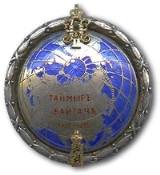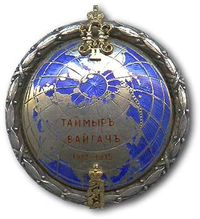
Icebreaker Taymyr
Encyclopedia

Taymyr Peninsula
The Taymyr Peninsula is a peninsula in the Far North of Russia, in the Siberian Federal District, that forms the northernmost part of mainland Eurasia and Asia...
.
Icebreaker Taymyr and its sister ship Vaygach
Icebreaker Vaygach
Icebreaker Vaygach was an icebreaking steamer of moderate size built for the Russian Imperial Navy at St. Petersburg in 1909. It was named after Vaygach Island in the Russian Arctic....
were built for the purpose of thoroughly exploring the uncharted areas of the Northern Sea Route
Northern Sea Route
The Northern Sea Route is a shipping lane officially defined by Russian legislation from the Atlantic Ocean to the Pacific Ocean specifically running along the Russian Arctic coast from Murmansk on the Barents Sea, along Siberia, to the Bering Strait and Far East. The entire route lies in Arctic...
. This venture became known as the Arctic Ocean Hydrographic Expedition.
Surveys
The first of a series of surveys began in the autumn of 1910, when the Taymyr and the Vaygach left VladivostokVladivostok
The city is located in the southern extremity of Muravyov-Amursky Peninsula, which is about 30 km long and approximately 12 km wide.The highest point is Mount Kholodilnik, the height of which is 257 m...
. They entered the Chukchi Sea
Chukchi Sea
Chukchi Sea is a marginal sea of the Arctic Ocean. It is bounded on the west by the De Long Strait, off Wrangel Island, and in the east by Point Barrow, Alaska, beyond which lies the Beaufort Sea. The Bering Strait forms its southernmost limit and connects it to the Bering Sea and the Pacific...
with scientists on board and began their exploration. For the next five years, these icebreakers went on sounding and carrying on vital surveys during the thaw. Before every winter, when ice conditions became too bad, they returned to Vladivostok and waited for the spring.
In 1911 the scientists and crew aboard the Vaygach and the Taymyr made the first Russian landing on Wrangel Island
Wrangel Island
Wrangel Island is an island in the Arctic Ocean, between the Chukchi Sea and East Siberian Sea. Wrangel Island lies astride the 180° meridian. The International Date Line is displaced eastwards at this latitude to avoid the island as well as the Chukchi Peninsula on the Russian mainland...
.
In 1914, Boris Vilkitsky
Boris Vilkitsky
Boris Andreyevich Vilkitsky was a Russian hydrographer and surveyor. He was the son of Andrey Ippolitovich Vilkitsky....
was both the captain of the Taymyr and the leader of the Arctic Ocean Hydrographic Expedition. The purpose of icebreakers Taymyr and Vaygach was to force the whole Northern Passage in order to reach Archangelsk. Severe weather and ice conditions, however, didn't allow them to cross the Kara Sea
Kara Sea
The Kara Sea is part of the Arctic Ocean north of Siberia. It is separated from the Barents Sea to the west by the Kara Strait and Novaya Zemlya, and the Laptev Sea to the east by the Severnaya Zemlya....
and they were forced to winter at Bukhta Dika, close to the Firnley Islands
Firnley Islands
The Firnley Islands, also spelt Firnleya or Firileya is a group of three small islands covered with tundra vegetation and with scattered stones on their shores. They lie in the Kara Sea, close to the bleak coast of Siberia's Taymyr Peninsula, not far east of the Nordenskjold Archipelago...
. Thus the sister icebreakers were able to complete the passage only in 1915. They were warmly welcomed in Archangelsk upon their arrival.
Some of the biggest successes of the expedition were the accurate charting of the Northern Sea Route and the discovery of Severnaya Zemlya
Severnaya Zemlya
Severnaya Zemlya is an archipelago in the Russian high Arctic at around . It is located off mainland Siberia's Taymyr Peninsula across the Vilkitsky Strait...
in 1913. Icebreakers Taymyr and Vaygach were considered the best icebreakers in the world in their time.
The first scientific drifting ice station
Soviet and Russian manned drifting ice stations
Soviet and Russian manned drifting ice stations are important contributors to exploration of the Arctic. The stations are named North Pole Soviet and Russian manned drifting ice stations are important contributors to exploration of the Arctic. The stations are named North Pole Soviet and...
in the world, North Pole-1
North Pole-1
North Pole-1 was the first Soviet manned drifting station, primarily used for research.North Pole-1 was established on May 21, 1937, and officially opened on June 6, some from the North Pole by the expedition into the high latitudes Sever-1, led by Otto Schmidt. The expedition had been airlifted...
was established on May 21, 1937 some 20 km from the North Pole by the expedition into the high latitudes Sever-1, led by Otto Schmidt
Otto Schmidt
Otto Yulyevich Schmidt was a Soviet scientist, mathematician, astronomer, geophysicist, statesman, academician, Hero of the USSR , and member of the Communist Party.-Biography:He was born in Mogilev, Russian Empire...
. "NP-1" operated for 9 months, during which the ice floe passed 2,850 kilometers. On February 19, 1938, Soviet icebreaker Taimyr, along with the Murman took off four polar explorers from the station, who immediately became famous in the USSR and were awarded titles Hero of the Soviet Union
Hero of the Soviet Union
The title Hero of the Soviet Union was the highest distinction in the Soviet Union, awarded personally or collectively for heroic feats in service to the Soviet state and society.-Overview:...
.
Nuclear vessels
A nuclear icebreaker of the Soviet Navy, as well as a class of nuclear-powered river icebreakers, was named TaymyrTaymyr (nuclear icebreaker)
Taymyr is a shallow-draft nuclear powered icebreaker, and the first of two similar vessels. She was built in 1989 for the Soviet Union in Finland, at the Helsinki New Shipyard by Wärtsilä, by order of the Murmansk Shipping Co....
in 1988.
External links
- I.Ye. Kuksin The Arctic Ocean hydrographic expedition 1910-1915 Polar Geography, Volume 15, Issue 4 October 1991 , pages 299 - 309 abstract on line
- William Barr http://epic.awi.de/Publications/Polarforsch1975_1_6.pdfA Tsarist attempt at opening the northern sea route: The arctic ocean hydrographic expedition, 1910-1915

